Deer hunting with dogs has long been a thrilling tradition stretching back centuries, especially in the southern and midwestern United States. Few sights compare to a pack of baying hounds hot on the trail of an antlered buck bounding through the autumn woods. While any breed of dog can be used, hounds like Plott Hounds, Bluetick Coonhounds, and Redbone Coonhounds are best suited for tracking deer with their superior sense of smell and tireless trailing abilities. When trained properly and used ethically, dogs are invaluable hunting partners for locating, driving, and retrieving whitetails and other deer.
In this comprehensive guide, we will cover optimal dog breeds, effective training tips, safety protocols, hunting techniques, and more advice for having a successful deer hunt with your loyal four-legged hunters. Whether an experienced deer dog handler or new to hunting with hounds, you’ll find essential information to prepare for hitting the woods this season.
What Breeds of Dogs are Best for Deer Hunting?
The most popular and effective dog breeds used for deer hunting are hounds. Hounds have a superior sense of smell, can track for long distances, have plenty of endurance, and a loud, baying bark that helps hunters follow them through dense woods and vegetation. Different hound breeds have attributes that make them excel in specific deer hunting tasks.
The Plott Hound is one of the most common breeds used for deer hunting in the United States. Plotts were originally bred in North Carolina for boar and bear hunting, but their tracking abilities transferred well to deer hunting too. They have an excellent sense of smell and are athletic enough to traverse rough terrain in pursuit of deer. Their loud barks allow hunters to follow them from afar. Plotts are bold and aggressive when on the trail.
Bluetick Coonhounds are known for their cold nose, meaning they excel at picking up and maintaining a scent trail. They are fast, athletic, and courageous when tracking deer. Blueticks are vocal trailers, making it easy for hunters to keep up. Their stamina allows them to track deer for miles without tiring. One downside is Blueticks can have a stubborn streak if not properly trained.
The Redbone Coonhound is another popular deer hunting companion in the southern United States. Redbones have amazing scenting power and the determination to stay on a deer’s trail no matter how far it runs. They are intelligent and eager to please but can get distracted by other critters if not focused on the task. Redbones have a distinctive bark that carries well through woods and hills when deer hunting.
Black and Tan Coonhounds are valued for their robust, deep baying bark that allows hunters to follow from long distances. They are tireless trackers. With their speed and athleticism, they excel at driving deer, flushing them from thickets, and pursuing them once shot. Bred to work in packs, they do exceptionally well in groups.
Overall, hound dogs make ideal deer hunting companions. Popular breeds like Plott Hounds, Bluetick Coonhounds, Redbone Coonhounds, and Black and Tan Coonhounds each bring something unique and valuable to the hunt. Their tracking abilities and loud voices are indispensable assets for a successful deer hunt.
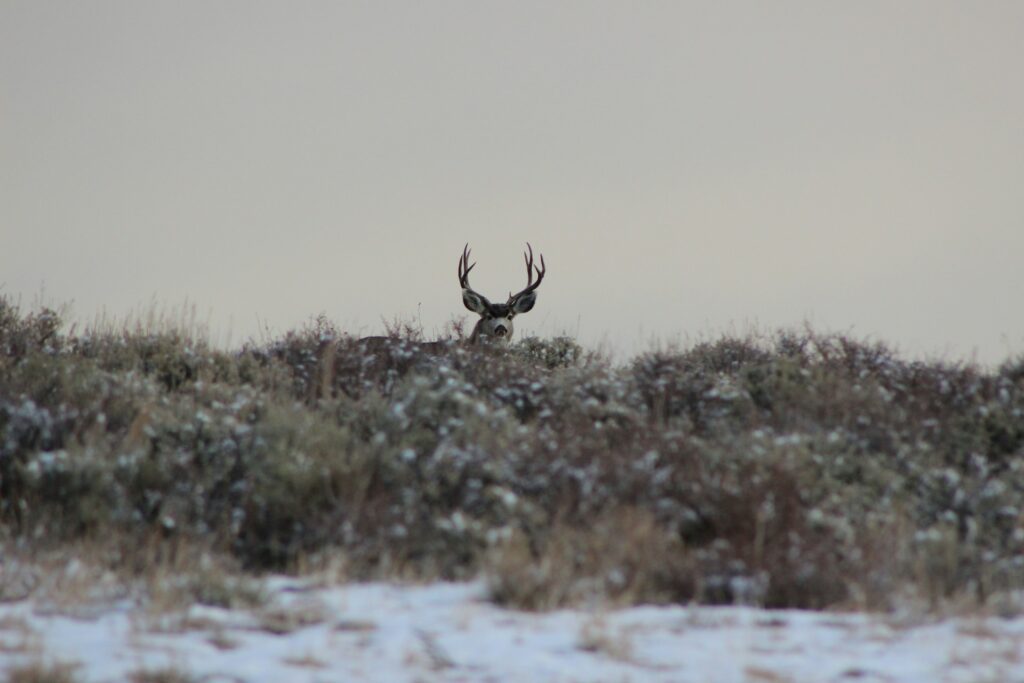
How to Train Your Dog for Deer Hunting?
Start training your puppy early, as soon as 12 weeks old. This allows you to shape their natural instincts at a young age. Expose the puppy to deer scents by letting it sniff deer antlers, hides, droppings, etc. Reward the puppy when it shows interest in the deer scents.
Work on basic obedience training first. The dog must have a solid “come,” “stay,” and “quiet” command. Being able to call your dog off a trail and prevent it from scaring deer away is crucial. Use treats and praise to positively reinforce obeying commands.
Take your dog on short tracking exercises by dragging deer hides or antlers behind you and having your dog follow the trail. Slowly increase the length and age of the trail over time. Reward with treats and excitement when your dog tracks the deer scent.
Move on to blood tracking exercises by scattering small amounts of deer blood for your dog to follow. Start with larger amounts then decrease the amount of blood over time. This prepares your dog to track a wounded deer. Always reward your dog for following the trail correctly.
Expose your dog to loud noises like gunshots by taking it to a hunting clay range. Get your dog comfortable sitting calmly beside you as you fire your rifle or shotgun. This prevents gun shyness.
Use scent bags that you can hide in the woods and have your dog search for. Scent bags contain deer urine, scents, and sometimes small amounts of food. Your dog will learn to use its nose to search for deer.
Take your dog on mock hunts and have it track trails you’ve created. Make the trails increasingly complex with twists, turns, false trails, etc. to challenge your dog. Always praise focused tracking.
The key is to start young, be consistent in training, use positive reinforcement like treats and praise, and gradually build your dog’s skills and stamina for long days in the deer woods. Patience and persistence in training will lead to success.
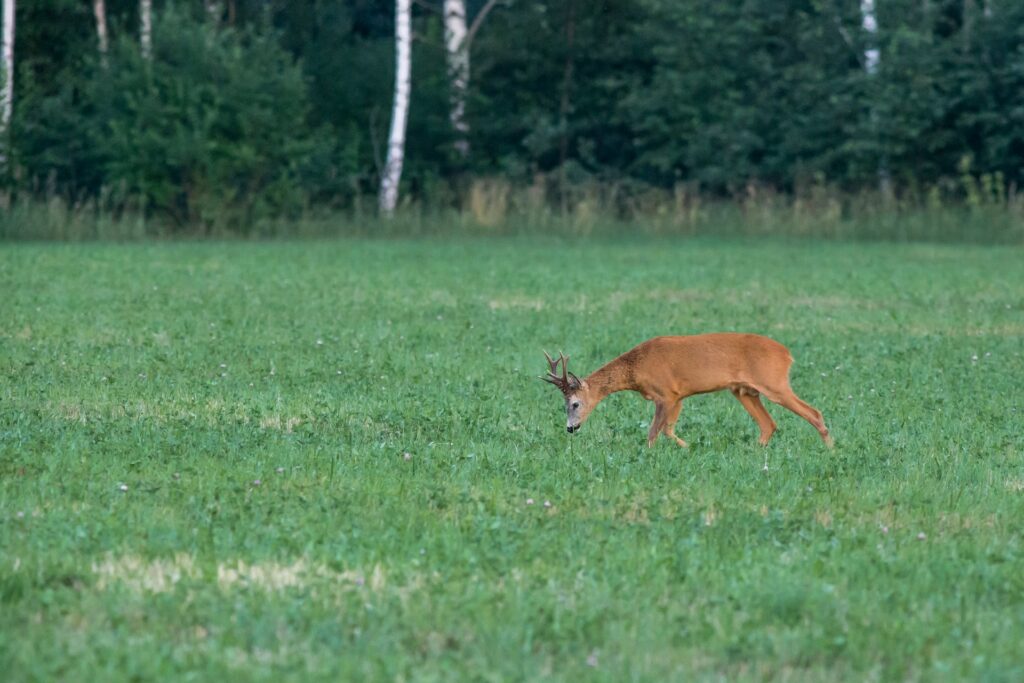
How Do Dogs Help Find and Chase Deer?
The most important skill dogs bring to deer hunting is their incredible sense of smell. A dog’s nose has up to 300 million scent receptors, whereas humans only have 5 million. This allows them to pick up fresh deer trails that humans would never detect. Even if the deer is far away, dogs can follow scent particles carried on the wind.
When set loose to search, dogs will roam woods and fields trying to pick up deer scent. Once they latch onto a trail, they will intently follow it, signaling to hunters through barks or howls that they are tracking. The dog’s sense of smell is so keen they can follow trails hours or even days old.
Athletic and energetic dog breeds will relentlessly pursue deer once they have the scent trail. They can chase deer for miles through dense woods, marsh, and brush that would exhaust or elude human hunters. The dog’s stamina is crucial for tracking wounded deer that run a long distance after being shot.
Bold, assertive dogs will bark and flush deer out of hiding spots in thickets, ravines, brush and other cover. Their loud baying also startles deer into movement, spooking them from their beds and prompting them to run. This often directs deer toward hunters.
Packs of dogs work exceptionally well together by surrounding deer and coordinating to drive them toward waiting hunters. Individual dogs can also herd and chase deer toward their hunting partners. Running deer often circle back, allowing hunters to intercept them.
Finally, dogs are helpful trackers after the shot by using their nose to follow blood trails left by wounded deer. This allows hunters to find the harvest that may otherwise be lost. The dog’s keen senses make them indispensable for locating downed deer.
In summary, dogs aid immensely in detecting, flushing, driving, and retrieving deer. Their scenting ability, stamina, speed, and assertiveness combine to make them highly-valued hunting partners for finding and chasing deer.
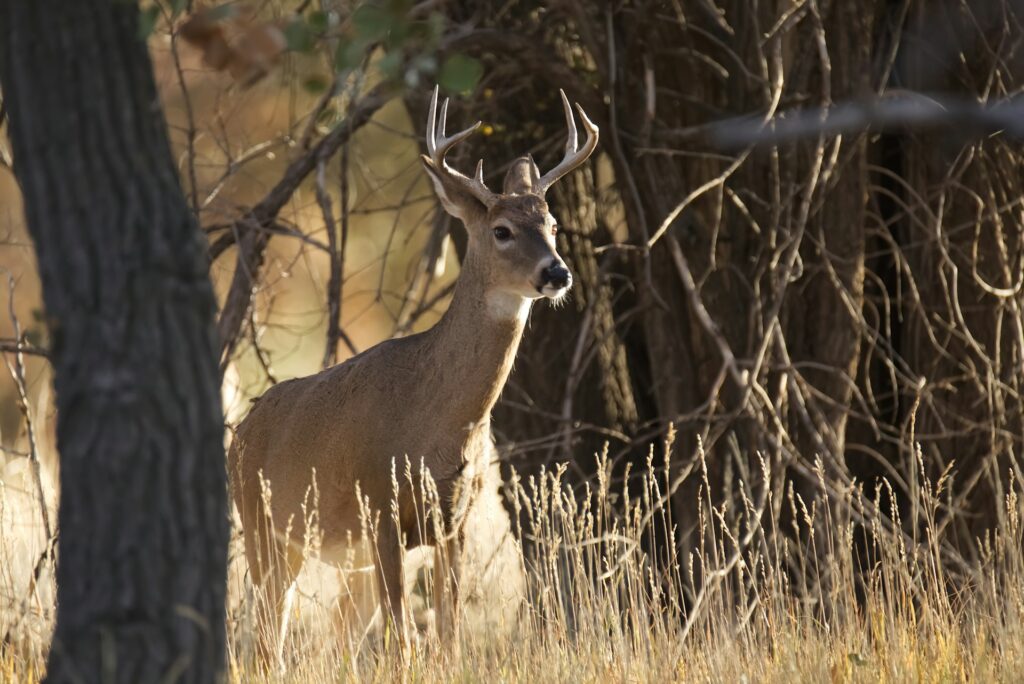
What Are the Best Techniques for Deer Hunting with Dogs?
Use the wind to your advantage. Position yourself downwind of where you expect deer to travel so your scent blows away from their location. This prevents them from being spooked and alerted. Dogs can help determine wind direction as they search.
Use a deer call to stop deer in their tracks. When your dog is in pursuit or deer are moving, a bleat call will cause them to pause briefly, allowing you time to get a shot. Practice calling realistically.
Take position at funnel points that deer naturally travel through like gaps between hills, corner points of fields, or creek crossings. Dogs will drive deer toward these choke points where you can intercept.
Set up an elevated stand downwind of deer trails, water sources, and feeding areas. Calling from an elevated position above the dog increases your visibility and shot range as deer are flushed.
Use decoys and scents to attract deer closer once they are pressured and fleeing from the dog. Set up decoys downwind and apply deer scent to draw them near your stand.
Partner with other hunters and have them set up downwind at a distance, allowing the dog to drive deer to multiple hunters spread across the field or woods. Coordinate by radio.
Use stealth when approaching once dogs have cornered or bayed up deer, moving slowly and quietly into shooting position without being detected. Use cover when possible.
Go still hunting without dogs to identify fresh sign like tracks and droppings. Then return with dogs later to track and chase those specific deer once their location is known.
Most importantly, stay downwind, use calls and decoys effectively, partner with dogs and other hunters, and always hunt ethically by making clean kill shots.
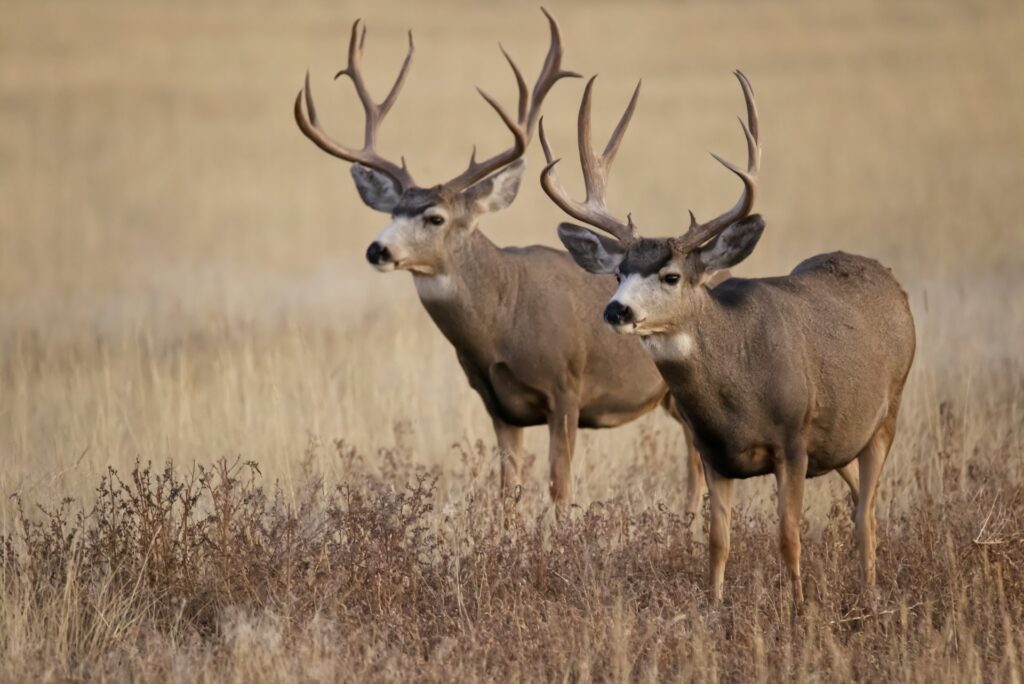
What Are Some Tips for a Successful Deer Hunt with Dogs?
Here are some top tips for having a successful deer hunt with dogs:
Start scouting early – Get to know the hunting area well before season and locate deer trails, feeding areas, water sources, bedding areas, and other deer signs.
Train your dog thoroughly – Invest time in obedience, tracking, and off-leash control. A disciplined dog is crucial for an effective hunt.
Check the wind regularly – Use a wind checker and adjust stand positions to stay downwind of expected deer movement.
Use estrous scents – Apply female deer urine or synthetic scents near your stand to attract bucks. Refresh scents frequently.
Equip for all-day hunts – Pack extra food, water, coats, boots, and gear so you and your dogs have the stamina to hunt from dawn to dusk.
Hunt food sources – Set up near acorn groves, fruit trees, agricultural fields, or other prime deer feeding spots at peak times.
Team up – Hunting with a partner and multiple dogs allows driving and intercepting deer from different directions.
Communicate with dogs – Use hand signals, whistles, and location devices to silently direct your dogs when pursuing deer.
Respect private property – Ask for permission before hunting or tracking wounded deer on private land. Follow landowner directions.
Aim for clean kills – Only take ethical shots that will result in clean, quick kills and minimal suffering.
With thorough preparation, effective communication, and dogs trained to follow commands, your deer hunting success will improve exponentially.
What Safety Precautions Should You Take When Deer Hunting with Dogs?
Here are some key safety precautions to take when deer hunting with dogs:
- Wear blaze orange – Both you and your dog should wear bright orange vests and collars so you are clearly visible to other hunters. This prevents accidental shootings.
- Use a GPS tracker – Put a GPS tracking collar on your dog so you can monitor their location from your smartphone. This helps prevent losing your dog.
- Give your dog a bell – Attach a bell to your dog’s collar so you can hear them coming and avoid shooting in that direction. The bell also scares deer less than a bark.
- Know your target – Make absolutely sure of your target before taking a shot. Avoid shooting at sound or glimpses to prevent injuring your dog.
- Follow leash laws – Check regulations and only have dogs off-leash where permitted. Leashes give you control over your dog in public areas.
- Monitor weather – Don’t hunt dogs in extreme heat or cold which could lead to injury or over-exhaustion. Be prepared with dog boots and coats.
- Watch for cliffs – Be aware of steep drop-offs and cliffs when chasing deer in mountainous areas. Dogs can become injured or stranded.
- Avoid high traffic areas – Don’t hunt dogs near major roads and trails where other people could interfere or get hurt.
- Give vaccination – Ensure your dog is vaccinated for potential diseases from wildlife like Leptospirosis before the hunt.
- Have a first aid kit – Bring a kit for your dog with medical supplies for treating cuts, sprains or other injuries. Know emergency vet contacts.
Following these rules helps protect both you and your four-legged hunting partner when out in the deer woods with dogs. Safety must be the top priority.
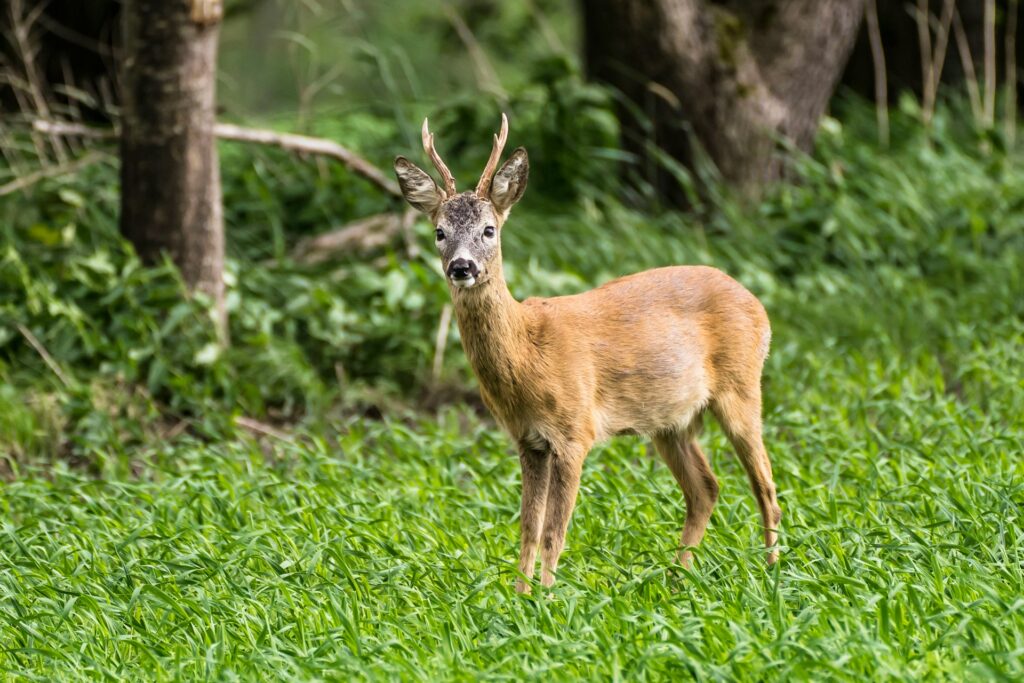
What Supplies and Equipment Do You Need for Deer Hunting with Dogs?
Collar and ID Tags – A collar with ID tags should always be worn by hunting dogs in case they wander off. A brightly colored collar makes spotting your dog easier. Electronic collars with GPS tracking are also useful.
Leash – A leash that attaches to your dog’s collar allows you to restrain and control your dog while tracking and approaching deer. A 20-30 foot leash is ideal.
Vest – A bright orange hunting vest for your dog improves visibility and safety. You want to be able to spot your dog in the brush while hunting.
First Aid Kit – Bring a kit containing medical supplies for your dog in case of injuries like cuts, sprains, etc. Bandages, antiseptic, tick removal tools, and emergency contact info should be included.
Treats and Food – Keep your hunting dog energized and motivated by bringing nutritious, high-protein treats and meals. Replenish fluids with a folding water bowl.
Whistle or Locator – Loud whistles or electronic dog locators allow you to signal your dog’s location from afar. This helps prevent losing track of your dog.
Maps – Carry updated maps of the area you’ll be hunting to prevent disorientation for both you and your dog. A GPS device is also extremely useful.
Deer Scent – Bring deer scent lures and attractants like deer urine to mask your smell and help draw deer near.
Gun and Ammo – Bring your rifle, shotgun, or crossbow with appropriate ammo for your target deer species. Ensure you hunt legally.
Field Dressing Kit – To prepare the deer after the kill, bring knives, wipes, trash bags, gloves, and other dressing tools.
Dog Boots – In rough terrain, booties protect your dog’s paw pads from abrasions and injuries.
The right gear will keep your hunting dog safe, comfortable, and performing at its best during the deer hunt. Focus on visibility, training aids, first aid preparedness, and equipment for field dressing and hauling deer after the harvest.
Enjoyed this guide of deer hunting with dogs? Then be sure to check out our other outdoor gears guides.